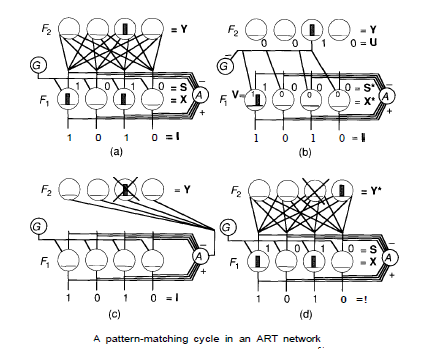Pattern Matching In Adaptive Resonance Theory
Introduction: -The scenario is a simple pattern-matching operation during which an ART network tries to determine whether an input pattern is among the patterns previously stored in the network.
A pattern of activation, X, is produced across F1. The processing done by the units on this layer is a somewhat more complicated form of that done by the input layer of the CPN .The same input pattern excites both the orienting subsystem, A, and the gain control, G (the connections to G are not shown on the drawings). The output pattern, S, results in an inhibitory signal that is also sent to A. The network is structured such that this inhibitory signal exactly cancels the excitatory effect of the signal from I, so that A remains inactive. Notice that G supplies an excitatory signal to F1. The same signal is applied to each node on the layer and is therefore known as a nonspecificsignal. The need for this signal will be made clear later.The appearance of X on F1 results in an output pattern, S, which is sent through connections to F2. Each FI unit receives the entire output vector, S. from F1.
F2 units calculate their net-input values in the usual manner by summing the products of the input values and the connection weights. In response to inputs from F1, a pattern of activity, Y, develops across the nodes of F2. F2 is a competitive layer that performs a contrast enhancement on the input signal like the competitive layer.
The gain control signals to F2 are omitted here for simplicity. In Figure (b), the pattern of activity, Y, results in an output pattern, U, from F2. This output pattern is sent as an inhibitory signal to the gain control system. The gain control is configured such that if it receives any inhibitory signal from F2, it ceases activity. U also becomes a second input pattern for the F1 units. U is transformed by LTM traces on the top-down connections from F2 to F1.
In Figure (c), A has become active in response to the mismatch of patterns on FI. A sends a nonspecific reset signal to all of the nodes on F2.These nodes respond according to their present state. If they are inactive, they do not respond. If they are active, they become inactive and they stay that way for an extended period of time.This sustained inhibition is necessary to prevent the same node from winning the competition during the next matching cycle. Since Y no longer appears, the top-down output and the inhibitory signal to the gain control also disappear.
In Figure (d), the original pattern, X, is reinstated on FI, and a new cycle of pattern matching begins. This time a new pattern, Y*, appears on F2. The nodes participating in the original pattern, Y, remain inactive due to the long term effects of the reset signal from A.